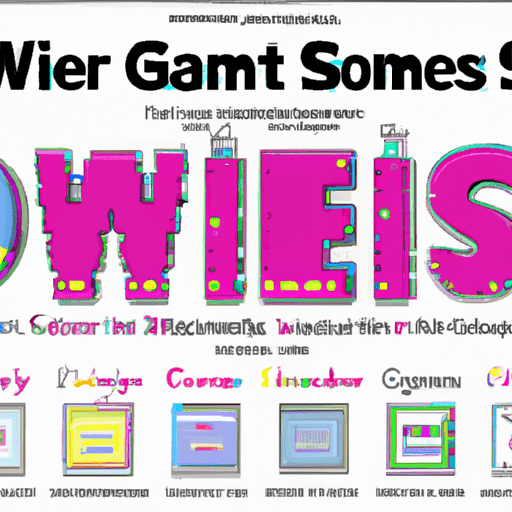# The Evolution of Web Design: From Text Walls to AI-Driven Experiences
## Introduction
Web design has come a long way since the birth of the first website in 1991. From text-heavy interfaces to sleek, modern designs, the evolution of web design is a testament to the progress of technology and user experience. In this article, we will take a trip down memory lane and explore the different eras of web design, highlighting key takeaways for today’s websites. We will also discuss the future of web design and the role of artificial intelligence (AI) in creating interactive experiences. So, buckle up and prepare to embark on a journey through the history of web design!
## Early 1990s: Antiquity
Let’s start our timeline in the early 90s when the internet was still in its infancy. With slow dial-up connections, websites had to be optimized for speed. Consequently, web pages were mostly walls of text devoid of visual elements and styling. However, these early websites were lightweight and optimized for slow connections, which is a design consideration that still holds relevance today.
### Takeaways for Today’s Websites
Even with faster internet speeds, it’s important to keep the user experience in mind. Complicated designs with heavy graphics and excessive animations can lead to higher bounce rates when load speeds are slow. Keeping it simple and focusing on usability should be a priority for modern websites.
## Mid-1990s: The Middle Ages
The mid-90s saw the advent of table-based layouts, allowing for greater flexibility and creativity in web design. Websites became more organized with the ability to divide text into columns, rows, and other navigational elements. Graphical design elements also became popular during this era, with page hit counters and animated text being prominent features.
### Takeaways for Today’s Websites
Table-based design may have been a norm in the mid-90s, but it’s not the best choice for modern websites. It leads to excessive markup, slow load times, and visual inconsistency. Today, page structure remains critical for navigation and content organization, determining how users experience and interact with your site.
## Late 1990s: The Renaissance
The late 90s marked the introduction of Flash, which revolutionized web design by enabling interactive and multimedia experiences. Flash allowed designers to incorporate animations, tiled background images, neon colors, and 3D buttons. This period saw a shift towards visitor-focused design, prioritizing appearance and usability over pure content.
### Takeaways for Today’s Websites
Flash may no longer be in use, but the emphasis on interactive and multimedia experiences remains. Modern websites rely on alternative methods such as CSS and JavaScript animations, as well as embedded videos for engaging user experiences.
## Early 2000s: The Enlightenment
The early 2000s brought about a focus on usability and flexibility in web design. The introduction of CSS allowed designers to separate content and style, making websites easier to maintain, more flexible, and quicker to load. This era also saw a better understanding of color psychology, leading to the use of whitespace and a decrease in garish colors. Navigation and strategic placement of content gained traction.
### Takeaways for Today’s Websites
Designing with usability in mind is crucial for modern websites. Users tend to scan websites, so intuitively placed information, visually accentuated links, and straightforward navigation are key elements for a successful website.
## Mid- to Late-2000s: The Industrial Revolution
The mid- to late-2000s witnessed the rise of Web 2.0, which brought about the growth of multimedia applications, interactive content, and social media. Design became more about content and search engine optimization (SEO), with the user at the center of the design. Aesthetic changes included better color distribution, increased use of icons, and greater attention to typography.
### Takeaways for Today’s Websites
SEO remains a top priority for most business websites. Designing with optimal keywords, inbound and outbound linking, and syndication technology are important considerations. However, it’s important to avoid spamming techniques and focus on providing valuable content to users.
## 2010 to Now: The Modern Era
In the modern era of web design, aesthetics have shifted towards minimalism with sparse content, flat graphics, simpler color palettes, and bold visuals. User experience (UX) has taken center stage, leading to features like infinite scrolling and single-page design. Mobile web design has also become a critical consideration due to the growing number of mobile users.
### Takeaways for Today’s Websites
Today, responsive design is essential to ensure a pleasing mobile user experience. Additionally, focusing on UX, using minimalistic designs, and optimizing websites for speed are crucial for modern web design.
## AI and the Future of Website Design
Looking ahead, the next big revolution in web design is AI. AI-driven websites offer fully interactive experiences through features like chatbots and personalized recommendations. AI enables faster and more efficient website building and optimization. The possibilities for web design are endless with the efficiency and intelligence that AI brings to the table.
## Closing Summary
The evolution of web design has been a remarkable journey, from text-based interfaces to AI-driven experiences. Each era of web design has brought its own unique contributions and lessons for modern websites. It’s essential to prioritize user experience, usability, and mobile optimization in today’s web design. As we look into the future, AI will continue to shape the way we design and interact with websites. So, embrace the evolution of web design and get ready for the exciting possibilities that lie ahead!

